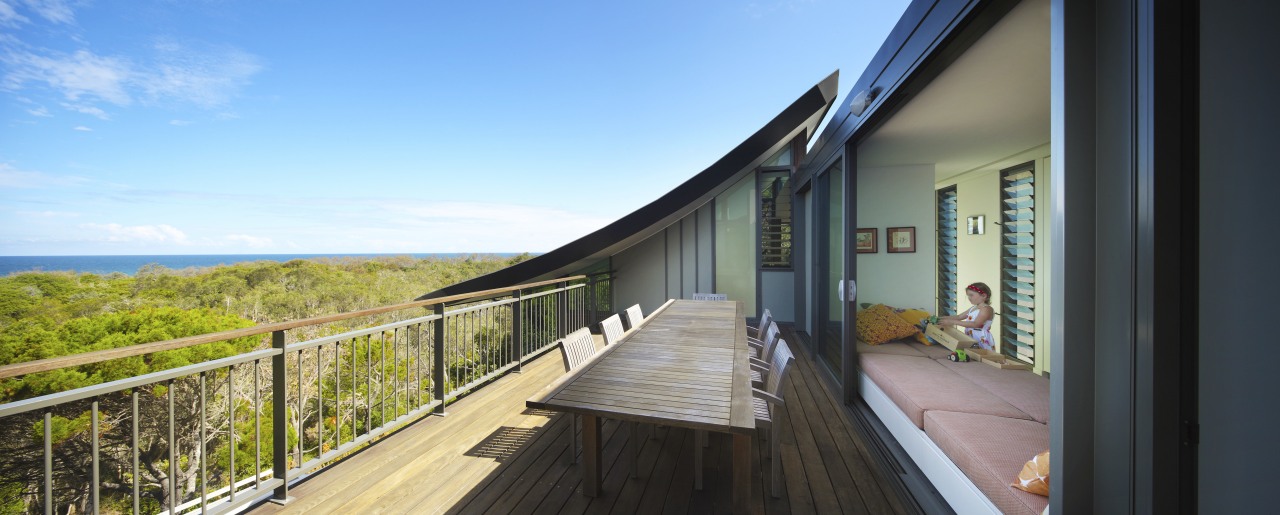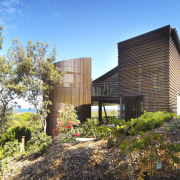Commanding perspective
Contemporary beach house

Architecture that is a response to the immediate surroundings always resonates more strongly than a design that appears to have popped out of nowhere.
This new house in a Queensland beachside township was influenced by the natural beauty of the location, says architect Dan Sparks.
"The site enjoys views down the length of the coast to the east, but to the west it overlooks the boxy, built forms of other beach houses, so the architecture references both these aspects.
"Essentially, the house has a duality, it forms a dialogue between the two. A rectilinear circulation spine and stair tower address the built environment to the west, while sweeping roof forms and decks play off the natural environment and the curves of the dunes."
The house comprises two main pods, one accommodating the living areas and several bedrooms, and the other housing the master suite. Bridges link rooms on different levels, with one bridge leading to the top of a circular lookout tower.
Sparks says the dimensions of the site determined a north-south axis, which meant all spaces could enjoy the view to the east.

"However, the nature of the site offered a far richer experience than simply the big ocean view," the architect says. "The house provides a series of viewing platforms, stretched along the length of the site and stacked through the various layers of vegetation.
"The lower levels very much engage with the undercroft of the banksias and melaleucas, and the wildlife of the pond. As you move up through the building the experience changes. At the middle level you look through the tree canopy; on the upper level you look over it to the ocean; and finally, when you reach the lookout nest, you can see the entire coastline."
The expansive use of glass, including clerestories, maximises these outlooks.
"The curved roofs sweep up, echoing the rise and fall of the vegetation, and the walls beneath these roofs are glazed, as are the roofs of the tower elements."
Light from the frosted glass roofs floods the stairwells, penetrating all floors, including the kitchen, which has a glazed wall behind the display cabinets.
Sparks says the living spaces have an intimacy and warmth that may be unexpected, due to the large size of the house.

"Contrary to the dynamic form, the interior is very relaxed and casual. With the bridges and lookout tower it even has a playful feel, and is reminiscent of a treehouse. Recycled materials reinforce the look."
Sparks says there are also many nooks and daybeds places where the family can sit and enjoy the view. Even the railing on the main deck off the living room is wide enough to serve as a breakfast bar. The balustrade slopes away so chairs can be tucked beneath the bar.
Consideration for the view determined the height of the living room platform as well. This is elevated above the deck so the views are not obstructed by the railing.
Key architectural elements also inform the viewing experience. For example, timber battens that wrap the circular tower in a raked pattern drop down below the bottom of the walls to define a seating area on the deck. And the low sweep of the roof frames key aspects.
Unusually for Queensland, the house has no air conditioning. Instead, the interior is cross ventilated, with the two stairwells serving as thermal chimneys.
"Air is pulled through the house from the wide-open doors and sucked out through smaller louvre windows at the top of the stairs," says Sparks. "It's very easy to trim the house to suit the wind direction, simply by opening or closing doors and windows. Even the bedrooms can be vented into the stairwells. The shape of the roof also helps to keep the interior cool hot air hits the roof and accelerates up the curve and away over the top, which enhances the pull of cross ventilation through the thermal chimneys."
Story by: Trendsideas
Home kitchen bathroom commercial design
9 tile shapes and finishes that think outside the square
Reflection and repose
White cloud, blue sky
Home Trends Vol. 30/4
New Home Trends features top locations from New Zealand and the rest of the world. New Home Trends is dedicated to provi...
Read More








